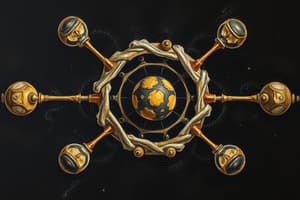Podcast
Questions and Answers
How many protons are in atom B?
How many protons are in atom B?
missing answer
How many protons are in atom A?
How many protons are in atom A?
missing answer
How many neutrons are in atom B?
How many neutrons are in atom B?
missing answer
How many neutrons are in atom A?
How many neutrons are in atom A?
How many electrons are in atom A?
How many electrons are in atom A?
How many electrons are in atom B?
How many electrons are in atom B?
What is the atomic weight of atom B?
What is the atomic weight of atom B?
What is the atomic weight of atom A?
What is the atomic weight of atom A?
Protons have a negative charge.
Protons have a negative charge.
Neutrons have no charge.
Neutrons have no charge.
What happens to electrons when two objects are rubbed together?
What happens to electrons when two objects are rubbed together?
Atoms with the same number of electrons and protons are neutral.
Atoms with the same number of electrons and protons are neutral.
Flashcards are hidden until you start studying
Study Notes
Parts of an Atom
- Elements are substances consisting of only one type of atom (e.g., oxygen, gold, silver, helium).
- Atoms are the smallest units of an element that retain its properties.
- Atoms of the same element are identical, while atoms of different elements have distinct characteristics.
- Except for hydrogen, all atoms have three main components: protons, electrons, and neutrons.
Components of an Atom
- Protons:
- Positively charged particles.
- Located in the nucleus at the center of the atom.
- Electrons:
- Negatively charged particles.
- Found in orbits or rings surrounding the nucleus.
- Their number equals the number of protons, ensuring the atom is neutral.
- Neutrons:
- Neutral particles with no charge.
- Located in the nucleus alongside protons.
Atomic Weight
- Protons and neutrons are heavy components, contributing to the atomic weight of an element.
- Electrons are extremely light and negligible in weight.
Charge and Static Electricity
- Atoms typically have equal numbers of electrons and protons, leading to a neutral charge.
- Charges can become separated through friction: rubbing two objects can transfer electrons, creating charged atoms (static electricity).
- Atoms gaining electrons become negatively charged.
- Atoms losing electrons become positively charged.
- Opposite charges attract; like charges repel each other.
Everyday Examples
- Rubbing hair with a hat can cause electrons to move from hair to hat, resulting in hair displaying a positive charge and standing up.
- Walking across a carpet can transfer electrons to the person; touching a metal doorknob can result in an electric shock as the excess electrons discharge.
Studying That Suits You
Use AI to generate personalized quizzes and flashcards to suit your learning preferences.




